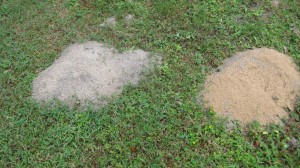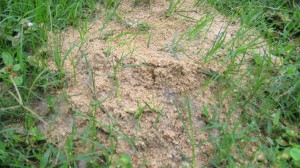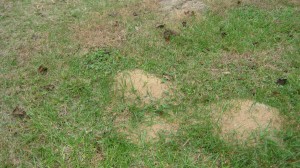Our branch got word that a large shipment of Christmas trees was being shipped to the area from the deep south and that these trees were infested with the dreaded stinging insect. We didn’t have the internet at the time but that didn’t stop the rumor mill from churning out impossible stories and the city buzzed with wary anticipation. I guess the trees came but the ants either died or lost interest because we never got call one. That didn’t stop people from getting yard treatments, preventative sprays (which came with an annual contract of course) and insecticidal granule sales went through the roof. Somewhere in the cloud of stories that swirled about granules emerged as the number one defense against this unholy beast and I think it still is the consensus #1 treatment today for homeowners.
When dealing with fire ants granules are not the worst choice in the world but the misapplication is; so many homeowners feel the need to put a 1/2 bag or more on each mound somehow thinking that this nuclear approach will eliminate the mound queen and all. I guess it’s better than grits or some other home remedy and in reality the mound does become inactive but you’d leave too if someone dumped the equivalent of 20 truck loads of granules on your home. For the fire ant, the sudden roof job in merely an inconvenience and instead of fighting it they simply use their subterranean tunnel system to build another mound sometimes not more than 6 inches away. The homeowner who was first so satisfied with their ‘shock & awe’
Mound treatments can be very effective but no so much with granules. For the DIY person drenching the mound with liquids is far more effective but requires anywhere from 1 to 3 gallons poured on and around the spot to get deep enough to kill the mound. Seems like overkill to me and not very responsible. Pro’s drench mounds too but use long probes to soak the nest and get the same results with far less material. Baits are another very useful tool and it is the ant that does the work of bringing the lethal dose to the depths of the nest which sometimes can be 3 feet below the surface. Again, we tend to use far too much bait and feel the need to put the poisoned matrix right on top of the ants castle by the bucket full which almost always ends up with the same results as with the granule.
If you are going to use granules for fire ant control the best way is always according to the label. Although I’m not well versed in every product out there I do know that most granules suggest an even layer across the entire yard. While it seems hitting the headquarters makes more sense, by treating the entire area you will kill more ants. It’s said of ants that most you’ll ever see of any colony is 10% and I believe that’s true. Foraging for food is a dangerous job and in the ant world they send the older more expendable ants out to do this perilous task. If the 10% go out and trail through the yard they will undoubtedly come across your barrier and most will die before ever making it back. The colony is forced to send more ants out for food and most of the new group meets the same fate. This continues until the ants either vacate to a less hostile area (which they will do) or the entire colony either dies from your treatment or lack of food.
This process takes awhile and most are unwilling to let it work so the immediate satisfaction of mound treatments continues. Granules have improved over the years and some now are formulated to give you a years worth of residual but even these require the magic of time. Baits too are far superior than yesteryears products but the cost for these more effective materials is something to consider. As the ants make their march from the south to new territory up north follow the granule sales and you can pretty much guess where they are. An easier way might just be to drive the neighborhood streets and look for mound cakes, thats always a sure sign.






